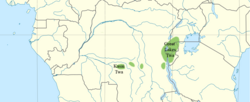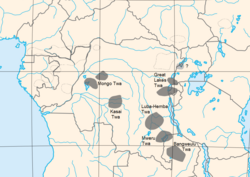 Twa populations according to Hewlett & Fancher. From west to east: Ntomba, Kasai, [unidentified], Great Lakes, Nsua [not clear if Nsua is Twa].  Twa populations according to Stokes. Only a few groups are shown, but these include several between the Kasai and Great Lakes Twa.  Twa/pygmoid populations according to Cavalli-Sforza. Several southern groups are added.  Twa populations scattered through shaded area, according to Blench. Several southern Twa areas are shown. | |
| Languages | |
|---|---|
| Bantu languages, French |
| Twa | |
|---|---|
| Person | Mutwa |
| People | Batwa |
| Language | (NA) |
| Country | Butwa [citation needed] |
The Twa, often referred to as Batwa or Mutwa (singular), are indigenous hunter-gatherer peoples of the Great Lakes Region in Central Africa, recognized as some of the earliest inhabitants of the area. Historically and academically, the term “Pygmy” has been used to describe these groups, however, it is considered derogatory, particularly by the Twa themselves. While some Batwa activists accept the term as an acknowledgement of their indigenous status, most prefer specific ethnic labels such as Bambuti (for the Ituri Forest region in the Democratic Republic of the Congo), Baaka (Lobaye Forest, Central African Republic), and Bambendjelle (Ndoki Forest, Congo-Brazzaville and Central African Republic).[1]
- ^ Lewis, Jerome (2000). The Batwa Pygmies of the Great Lakes Region. London: Minority Rights Group International. p. 5.